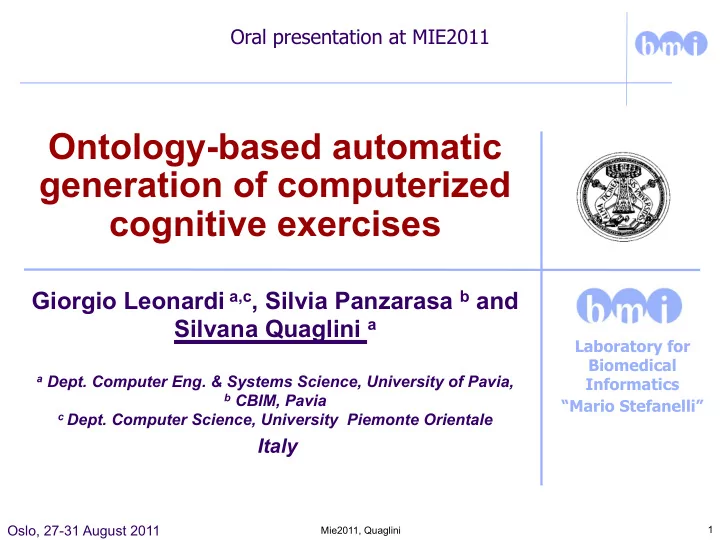

Oral presentation at MIE2011 Ontology-based automatic generation of computerized cognitive exercises Giorgio Leonardi a,c , Silvia Panzarasa b and Silvana Quaglini a Laboratory for Biomedical a Dept. Computer Eng. & Systems Science, University of Pavia, Informatics b CBIM, Pavia “Mario Stefanelli” c Dept. Computer Science, University Piemonte Orientale Italy Oslo, 27-31 August 2011 Mie2011, Quaglini 1
Cognitive rehabilitation exercises: examples Choose the correct category
… examples Complete Spaghetti : PASTA the = logical Hamburger : ? similarity MEAT VEGETABLE CEREAL
…examples Ordering of scenes 4 Mie2011, Quaglini
Background l Several (research/commercial) systems exist COGREHAB for moving cognitive rehabilitation l from paper to computer l from face-to-face encounters to homecare REHACOM l Not to replace the therapist but to enforce and intensify the rehabilitation l Among open problems ANASTASIS l Automatic patient-tailoring Serious ? l According to patient’s skill/performances games l According to patient’s preferences l Generating ever new exercises Mie2011, Quaglini 5
Aim of the work - To build an architecture allowing easy maintainance and updating of a repository of stimuli (images, words, sounds, etc.) to be used for the exercise generation, with • Hierarchical classification of stimuli • Full description of every stimulus • Relationships among stimuli • Relationships between stimuli and specific patients - Using the repository to generate personalised exercises within the E-prime tool - Maintaining the separation between the stimuli repository and the exercise-generator software, for sake of re-usability Mie2011, Quaglini 6
Methods: Protégé for the stimuli ontology An ontology is composed by a hierarchy of classes (containing the domain concepts), attributes (defining the intrinsic properties of a class) and relationships (defining semantic links between different classes). Mie2011, Quaglini 7
Export from Protégé Mie2011, Quaglini 8
From Protégé to a Relational DB Translator tool Mie2011, Quaglini 9
Adding patient’s data at local level Patient’s data Patient’s profiling Mie2011, Quaglini 10
Exploiting ontological relationships Mie2011, Quaglini 11
To create ever new exercises These exercises exploit the relationships between a course and its ingredients and between an animal and its habitations Mie2011, Quaglini 12
To make exercise more/less difficult Spaghetti : PASTA Spaghetti : PASTA = = Hamburger : ? Hamburger : ? MEAT VEGETABLE CEREAL MEAT VEGETABLE CEREAL FISH CHEESE
To tailor exercise according to a patient’s profile ü Showing the patient’s dog instead of a generic dog ü Using classes corresponding to the patient’s hobbies and interests ü Using easy or difficult stimuli according to the patient’s scholarity ü ...
... less difficult Using the same relationship “OPPOSITE”
... More difficult Using different relationships uses Lives in Made of
Different Complexity for the same exercise Food Find the right category First Second Dessert … Animals Mammals Birds Insects ... Food Animal Habitation For humans House Floor Habitation … For animals Stable Nest …
Increasing complexity by going into subclasses Food Find the right category First Second Dessert … Animals Mammals Birds Insects ... Habitation For humans House Floor … For animals Stable Nest …
Conclusions l Every update to the common stimuli repository is made at the ontology level to maintain consistency l At the local level l The patient’s data are integrated l the concept table may be enriched with patient-specific stimuli l The “interest” relationship between concepts and patient may be valued l This keep knowledge level and data level separate, allowing l easy personalisation l re-using the stimuli ontology in different contexts Mie2011, Quaglini 19
The final architecture stimuli Mie2011, Quaglini 20
Acknowledgments l The medical staff of l the Neurological Hospital “C. Mondino”, Pavia (Prof. Sandrini, Dr. Sinforiani, Dr. Zucchella) l the Rehabilitation Hospital “S. Maugeri”, Pavia (Dr. Pistarini, Dr. Cattani) Mie2011, Quaglini 21
Thank you Laboratory of Biomedical Informatics “Mario Stefanelli” Department of Computer Science and Systems, University of Pavia, Italy www.labmedinfo.org silvana.quaglini@unipv.it Mie2011, Quaglini 22
One-month report
Recommend
More recommend